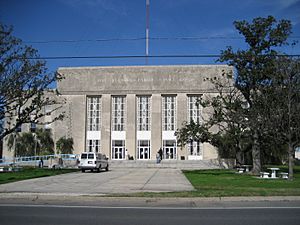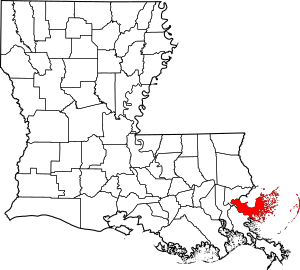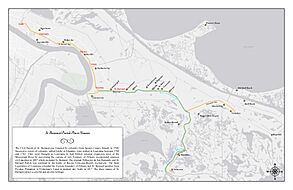St. Bernard Parish, Louisiana facts for kids
Quick facts for kids
St. Bernard Parish
|
|||
|---|---|---|---|

St. Bernard Parish Courthouse
|
|||
|
|||

Location within the U.S. state of Louisiana
|
|||
 Louisiana's location within the U.S. |
|||
| Country | |||
| State | |||
| Founded | March 31, 1807 | ||
| Named for | Bernardo de Galvez | ||
| Seat | Chalmette | ||
| Largest community | Chalmette | ||
| Area | |||
| • Total | 2,158 sq mi (5,590 km2) | ||
| • Land | 378 sq mi (980 km2) | ||
| • Water | 1,781 sq mi (4,610 km2) 83% | ||
| Population
(2020)
|
|||
| • Total | 43,764 | ||
| • Density | 115.78/sq mi (44.70/km2) | ||
| Time zone | UTC−6 (Central) | ||
| • Summer (DST) | UTC−5 (CDT) | ||
| Congressional district | 1st | ||
St. Bernard Parish (also known as French: Paroisse de Saint-Bernard or Spanish: Parroquia de San Bernardo) is a special type of county called a parish in Louisiana. Its main town and biggest community is Chalmette. The parish was officially created in 1807.
St. Bernard Parish is located southeast of New Orleans. It is part of the larger New Orleans–Metairie area. The parish also includes the Chandeleur Islands and Chandeleur Sound to its east.
From 2010 to 2020, St. Bernard was the fastest-growing parish in Louisiana. Its population grew from 35,897 in 2010 to 43,764 in 2020. However, this is still less than two-thirds of its population before Hurricane Katrina in 2005.
Contents
Exploring St. Bernard Parish History
St. Bernard Parish has a large community of people with Spanish roots. These people are sometimes called "Spanish Cajuns." They are known as the Isleños, meaning "islanders." Their ancestors came from the Canary Islands. This group developed its own special way of speaking Spanish.
The Isleños settled along Bayou Terre aux Boeufs. This bayou was once a path for the Mississippi River. The name Terre aux Bœufs means 'land of oxen' in French. It was likely named because cattle were found there. Spanish officials called this settlement La Concepción or Nueva Gálvez. The area was also known as Tierra de Bueyes, which is Spanish for 'land of oxen'. The name Saint Bernard was used in documents to honor colonial governor Bernardo de Gálvez.
St. Bernard Parish is also home to the oldest Filipino community in the United States. This community is called Saint Malo, Louisiana.
Famous Battle of New Orleans
The most important historical site in St. Bernard Parish is the Chalmette Battlefield. This is where the Battle of New Orleans happened on January 8, 1815. This battle was a key event during the War of 1812. Many streets near the battlefield are named after important people from the battle. Some even have pirate names, because the pirate Jean Lafitte was a hero in the fight. A school was named after Andrew Jackson, who led the American forces defending New Orleans.
In 1863, Abraham Lincoln mentioned St. Bernard Parish in the Emancipation Proclamation. He noted it as an area that was not fighting against the Union during the Civil War.
From 1919 to 1969, a local politician named Leander Perez had a lot of control over the parish. He was a powerful Democratic official.
The 1868 St. Bernard Parish Massacre
In 1868, a terrible event known as the St. Bernard Parish massacre took place. This happened during the Reconstruction era, just before the 1868 Presidential election. When Black men gained the right to vote, some white Democrats in the parish worried about losing power.
Armed groups used violence to stop these newly freed voters. They wanted to help the Democrat candidate, Horatio Seymour, win the election. A Seymour victory would mean the end of Reconstruction in the South. Many freedmen were pulled from their homes and killed. Others ran into the cane fields to hide.
This violence worked to stop Republican votes. Ulysses S. Grant, the Republican candidate, received only one vote from St. Bernard Parish. This was despite most people in the parish being Republican. The number of freedmen killed is believed to be between 35 and 135. Two white people were also killed while trying to help the victims.
The Great Mississippi River Flood of 1927
During the Great Mississippi Flood of 1927, leaders in New Orleans decided to blow up a levee (a protective wall) at Caernarvon. This was about 13 miles (21 km) below Canal Street. They did this to try and save New Orleans from flooding.
At the time, people in New Orleans thought this action saved their city. However, historians now believe it was not needed. This is because other levees upstream had already broken, which relieved pressure on the New Orleans levees. Blowing up the levee caused major flooding and damage in most of Eastern St. Bernard Parish. It also affected parts of Plaquemines Parish. The people who lost their homes and property were never fully paid back for their losses.
Hurricane Katrina in 2005
On August 29, 2005, Hurricane Katrina caused huge damage to St. Bernard Parish. The storm hit the eastern part of the parish directly. It pushed a 25-foot (7.6 m) storm surge into the Mississippi River Gulf Outlet ("MRGO"). This powerful surge destroyed the parish's protective levees.
Almost the entire parish was flooded. Most areas had between 5 and 15 feet (1.5 to 4.6 m) of water. The water rose very quickly, with witnesses saying it happened in about fifteen minutes. In many places, houses were destroyed or washed away by the storm surge. The water was even higher than the roofs of some homes.
For over two months after the storm, many parts of the parish had no electricity, water, or sewage services. The parish president, Henry "Junior" Rodriguez, said that all homes in the parish were unlivable.
Many groups helped the parish recover. For example, Emergency Communities built the Made with Love Cafe and Grill. This was a free kitchen and community center. It served 1500 meals a day and offered food and clothing. Another group, the H.O.P.E. Project, helped people rebuild their homes. The St. Bernard Project also helped residents get back into their homes by providing tools and support.
By October 2006, the population was estimated to be 25,489. Schools began to reopen for elementary grades in the 2006–2007 school year.
Hurricane Ida in 2021
Hurricane Ida made landfall on August 29, 2021. St. Bernard Parish experienced heavy flooding from this storm. Days before, officials warned people to get ready for the storm. They said the storm surge could reach up to 11 feet (3.4 m). The parish president, Guy McInnis, decided not to order a full evacuation.
Geography and Natural Features
St. Bernard Parish covers a total area of 2,158 square miles (5,589 km²). Most of this area, about 1,781 square miles (4,613 km²), is water. This means 83% of the parish is water, which is the highest percentage for any parish in Louisiana. It is also the second-largest parish in Louisiana by total area.
The parish includes many small islands. The land areas are mostly made of rich soil from rivers. These fertile areas cover about 37,000 acres (150 km²). The main waterways are the Bayous Terre aux Boeufs and La Loutre. There are also many smaller streams that help drain the land. The most common tree is the bald cypress, though many valuable trees have been cut down.
Important Water Bodies
- Lake Borgne (to the north)
- Mississippi River (to the southwest)
- Gulf of Mexico (to the east)
Main Roads
Neighboring Areas
- Hancock County, Mississippi (north)
- Harrison County, Mississippi (northeast)
- Orleans Parish (northwest)
- Plaquemines Parish (south)
- St. Tammany Parish (northwest)
Protected Natural Areas
- Breton National Wildlife Refuge (part of it)
- Jean Lafitte National Historical Park (part of it, in Chalmette)
State Parks
Communities in St. Bernard Parish
St. Bernard Parish does not have any official cities or towns. Instead, it has several communities.
Main Communities
These are areas where many people live, as identified by the U.S. Census Bureau:
Other Communities
These are smaller, unincorporated communities:
Old Communities (Ghost Towns)
These are places that were once communities but are now abandoned:
- Alluvial City
- Fazendeville
- Proctorville
- St. Malo
People and Population
| Historical population | |||
|---|---|---|---|
| Census | Pop. | %± | |
| 1810 | 1,020 | — | |
| 1820 | 2,635 | 158.3% | |
| 1830 | 3,356 | 27.4% | |
| 1840 | 3,237 | −3.5% | |
| 1850 | 3,802 | 17.5% | |
| 1860 | 4,076 | 7.2% | |
| 1870 | 3,553 | −12.8% | |
| 1880 | 4,405 | 24.0% | |
| 1890 | 4,326 | −1.8% | |
| 1900 | 5,031 | 16.3% | |
| 1910 | 5,277 | 4.9% | |
| 1920 | 4,968 | −5.9% | |
| 1930 | 6,512 | 31.1% | |
| 1940 | 7,280 | 11.8% | |
| 1950 | 11,087 | 52.3% | |
| 1960 | 32,186 | 190.3% | |
| 1970 | 51,185 | 59.0% | |
| 1980 | 64,097 | 25.2% | |
| 1990 | 66,631 | 4.0% | |
| 2000 | 67,229 | 0.9% | |
| 2010 | 35,897 | −46.6% | |
| 2020 | 43,764 | 21.9% | |
| U.S. Decennial Census 1790-1960 1900-1990 1990-2000 2010-2013 |
|||
In 2020, St. Bernard Parish had 43,764 people living there. This was an increase from 35,897 people in 2010.
The people living in St. Bernard Parish come from many different backgrounds:
- About 52.93% are White (not Hispanic).
- About 25.98% are Black or African American.
- About 0.49% are Native American.
- About 2.22% are Asian.
- About 4.63% are from two or more races.
- About 13.73% are Hispanic or Latino (of any race).
Most people in the parish, about 90.7%, speak English at home. About 5.5% speak Spanish.
The average age of people in the parish is 34.2 years old. About 73.2% of the population is 18 years or older. Most homes are owned by the people living in them, with a home-ownership rate of 67.7%. The average household income was $44,661.
The main religion in the parish is Christianity. Most religious people are part of the Roman Catholic Church. Baptists are the second-largest Christian group.
Education in St. Bernard Parish
Public schools in St. Bernard Parish are run by the St. Bernard Parish Public Schools district.
After Hurricane Katrina in 2005, all the parish's public schools were combined into one school, called the St. Bernard Unified School (SBUS). In the 2006–2007 school year, this unified school then split back into several different schools.
The parish also has Nunez Community College. Delgado Community College also has a campus nearby in East New Orleans.
There is one Catholic school in St. Bernard Parish, called Our Lady of Prompt Succor. There is also a private Montessori school, Classique Academy.
Fun Activities and Sports
- Frederick J. Sigur Civic Center: This center has an auditorium and a ballroom for events.
- Val Riess Recreation Complex: This complex offers baseball fields, softball fields, and a multi-purpose building for various sports and activities.
Local News and Media
While St. Bernard Parish mainly gets its news from New Orleans media, it also has its own newspapers. The St. Bernard Voice, started in 1890, is the official newspaper of the parish. The St. Bernard News started in 1967 and publishes weekly.
Famous People from St. Bernard Parish
- Renato Beluche
- P. G. T. Beauregard
- Walter Boasso
- A. G. Crowe
- Chris Dier
- Albert Estopinal
- Frank Fernández Jr.
- Ray Garofalo
- Alcide "Yellow" Núñez
- Samuel B. Nunez, Jr.
- Irvan "Puco" Pérez
- Leander Perez
- François Marie, Chevalier de Reggio
- Mitchell Robinson
- Junior Rodriguez
- Jean Saint Malo
- Elmer R. Tapper
- Jacques Villeré
- Norris Weese
- Tommy Wiseau
Images for kids
See also
 In Spanish: Parroquia de St. Bernard para niños
In Spanish: Parroquia de St. Bernard para niños









